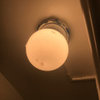PoCo obligations?
nicemac
15 years ago
Related Stories

GARDENING AND LANDSCAPINGGrow a Lush Privacy Screen
No need to wait forever for patio privacy the green way. These 10 ideas will get your screening up and running in no time
Full StoryI was about (with help and guidance of electrician friend) install a new meter base and breaker box to power my now-completed workshop. We called the PoCo to come pull the meter and they put on the brakes. Seems in '77 when my house was built, they only required 0 gauge wire for my (direct-buried) underground service. They told me to upgrade from the 225A box I have now to the 325A service I need, I would likely need to replace my wire from the pull box with 0000 gauge wire. Since my shop is only MOVING from the attached garage to the detached shop, the impact would be minimal difference. They agreed to put a graphing meter on my service to determine voltage drop and current draw, and considered "grandfathering" me in.
The current draw was fine, however, they say my voltage stays below 114v to much to allow any service "upgrade." It spent several minutes, at various intervals Saturday at 110v. I am in the South and we had 98F Saturday, so A/C was on all day.
I am tasked with digging 180' of trench, cutting up 40' of my driveway and buying/ installing 230' of 3-inch conduit but they will furnish, pull and connect the new wiring.
My question is this:
What should the PoCo be responsible for? I am under-volts now, without an overload on my existing system. (That they approved and connected as a 225A service in 1977) Shouldn't they be responsible for providing at least the minimum (114v) all the way to my meter? I understand if I was overloading my existing service, but I am under 60% rated (Amps) load most times and my peak usage was 77% rated load (for 2 cycles only) when my A/C kicked on while running dryer, oven, and other appliances during testing.
I understand they want me to upgrade, and I understand I need to protect my motors and compressors (fridges, A/C, etc...) but gee, I would think they should replace the wire to the meter if it isn't even carrying my existing load. (They told me if I was was above-ground, they would foot the bill, but since it is underground, they will only replace it if I open the ditch and install the conduit.)
This is going to cost me at least two days off work and the equipment rental expense of getting the ditch and conduit ready. Not to mention, I will have an 8-inch section of my driveway 40' long that will be a mis-match and will always look bad...
Do I need to shut up and cough up the dough, of is there some argument I can make to the PoCo that will trigger them stepping up and just fixing their inadequate wiring to my meter?




wirenut1110
davidandkasie
bus_driver
joed
tom_o
hexus
nicemacOriginal Author
brickeyee
gilshultz
nicemacOriginal Author
brickeyee
nicemacOriginal Author
solarpowered
nicemacOriginal Author
hendricus
nicemacOriginal Author
brickeyee
nicemacOriginal Author
brickeyee